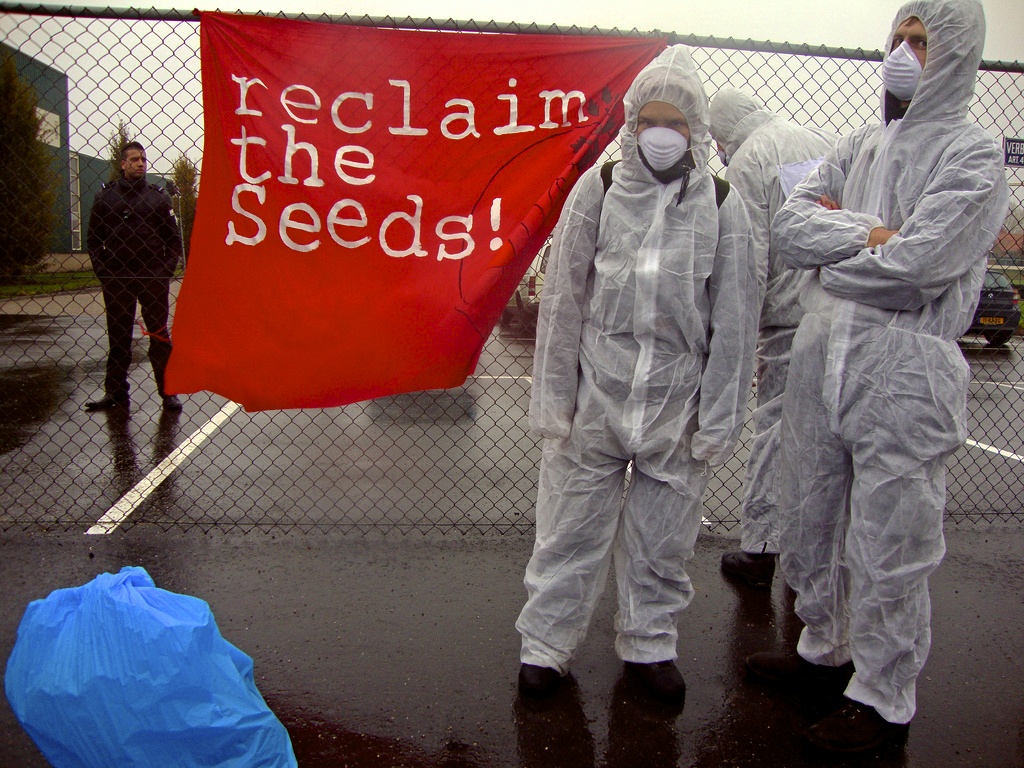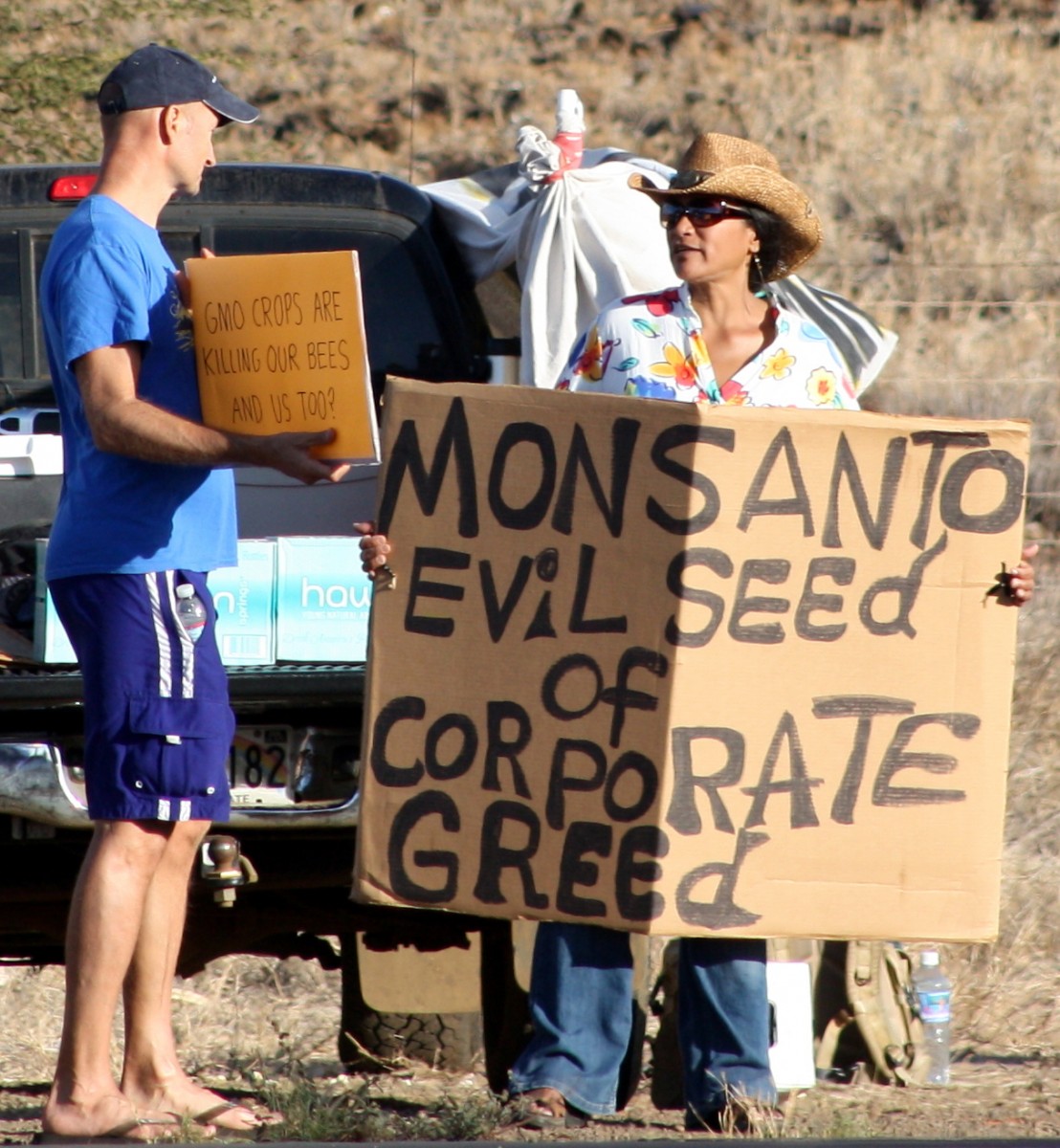
Forty percent of the crops grown in the United States contain their genes. They produce the world’s top selling herbicide. Several of their factories are now toxic Superfund sites. They spend millions lobbying the government each year. It’s time we take a closer look at who’s controlling our food, poisoning our land, and influencing all three branches of government. To do that, the watchdog group Food and Water Watch recently published a corporate profile of Monsanto.
Patty Lovera, Food and Water Watch assistant director, says they decided to focus on Monsanto because they felt a need to “put together a piece where people can see all of the aspects of this company.”
“It really strikes us when we talk about how clear it is that this is a chemical company that wanted to expand its reach,” she says. “A chemical company that started buying up seed companies.” She feels it’s important “for food activists to understand all of the ties between the seeds and the chemicals.”
Monsanto the Chemical Company
Monsanto was founded as a chemical company in 1901, named for the maiden name of its founder’s wife. Its first product was the artificial sweetener saccharin. The company’s own telling of its history emphasizes its agricultural products, skipping forward from its founding to 1945, when it began manufacturing agrochemicals like the herbicide 2,4-D.
Prior to its entry into the agricultural market, Monsanto produced some harmless – even beneficial! – products like aspirin. It also made plastics, synthetic rubber, caffeine, and vanillin, an artificial vanilla flavoring. On the not-so-harmless side, it began producing toxic PCBs in the 1930s.
According to the new report, a whopping 99 percent of all PCBs, polychlorinated biphenyls, used in the U.S. were produced at a single Monsanto plant in Sauget, IL. The plant churned out toxic PCBs from the 1930s until they were banned in 1976. Used as coolants and lubricants in electronics, PCBs are carcinogenic and harmful to the liver, endocrine system, immune system, reproductive system, developmental system, skin, eye, and brain.
Even after the initial 1982 cleanup of this plant, Sauget is still home to two Superfund sites. (A Superfund site is defined by the EPA as “an uncontrolled or abandoned place where hazardous waste is located, possibly affecting local ecosystems or people.”) This is just one of several Monsanto facilities that became Superfund sites.
Monsanto’s Shift to Agriculture
Despite its modern-day emphasis on agriculture, Monsanto did not even create an agricultural division within the company until 1960. It soon began churning out new pesticides, each colorfully named under a rugged Western theme: Lasso, Roundup, Warrant, Lariat, Bullet, Harness, etc.
Left out of Monsanto’s version of its historical highlights is an herbicide called Agent Orange. The defoliant, a mix of herbicides 2,4-D and 2,4,5-T, was used extensively during the war in Vietnam. The nearly 19 million gallons sprayed in that country between 1962 and 1971 were contaminated with dioxin, a carcinogen so potent that it is measured and regulated at concentrations of parts per trillion. Dioxin was created as a byproduct of Agent Orange’s manufacturing process, and both American veterans and Vietnamese people suffered health problems from the herbicide’s use.
Monsanto’s fortunes changed forever in 1982, when it genetically engineered a plant cell. The team responsible, led by Ernest Jaworski, consisted of Robb Fraley, Stephen Rogers, and Robert Horsch. Today, Fraley is Monsanto’s executive vice president and chief technology officer. Horsch also rose to the level of vice president at Monsanto, but he left after 25 years to join the Gates Foundation. There, he works on increasing crop yields in Sub-Saharan Africa. Together, the team received the National Medal of Technology from President Clinton in 1998.
The company did not shift its focus from chemicals to genetically engineered seeds overnight. In fact, it was another 12 years before it commercialized the first genetically engineered product, recombinant bovine growth hormone (rbGH), a controversial hormone used to make dairy cows produce more milk. And it was not until 1996 that it first brought genetically engineered seeds, Roundup Ready soybeans, onto the market.
By 2000, the company had undergone such a sea change from its founding a century before that it claims it is almost a different company. In Monsanto’s telling of its own history, it emphasizes a split between the “original” Monsanto Company and the Monsanto Company of today. In 2000, the Monsanto Company entered a merger and changed its name to Pharmacia. The newly formed Pharmacia then spun off its agricultural division as an independent company named Monsanto Company.
Do the mergers and spinoffs excuse Monsanto for the sins of the past committed by the company bearing the same name? Lovera does not think so. “I'm sure there's some liability issues they have to deal with – their various production plants that are now superfund sites,” she responds. “So I'm sure there was legal thinking about which balance sheet you put those liabilities on” when the company split. She adds that the notion that today’s Monsanto is not the same as the historical Monsanto that made PCBs is “a nice PR bullet for them.”
But, she adds, “even taking that at face value, that they are an agriculture company now, they are still producing seeds that are made to be used with chemicals they produce.” For example, Roundup herbicide alone made up more than a quarter of their sales in 2011. The proportion of their business devoted to chemicals is by no means insignificant.
Monsanto’s pesticide product line includes a number of chemicals named as Bad Actors by Pesticide Action Network. They include Alachlor (a carcinogen, water contaminant, developmental/reproductive toxin, and a suspected endocrine disruptor), Acetochlor (a carcinogen and suspected endocrine disruptor), Atrazine (a carcinogen and suspected endocrine disruptor), Clopyralid (high acute toxicity), Dicamba (developmental/reproductive toxin), and Thiodicarb (a carcinogen and cholinesterase inhibitor).
Roundup: The Benign Herbicide?
Defenders of Monsanto might reply to the charge that Roundup is no Agent Orange. In fact, the herbicide is viewed as so benign and yet effective that its inventor, John E. Franz, won the National Medal of Technology. Glyphosate, the active ingredient in Roundup, kills everything green and growing, but according to Monsanto, it only affects a metabolic pathway in plants, so it does not harm animals. It’s also said to break down quickly in the soil, leaving few traces on the environment after its done its job.
Asked about the harmlessness of Roundup, Lovera replies, “That’s the PR behind Roundup – how benign it was and you can drink it and there’s nothing to worry about here. There are people who dispute that.” For example there is an accusation that Roundup causes birth defects. “We don’t buy the benign theory,” continues Lovera, “But what’s really interesting is that we aren’t going to be having this conversation pretty soon because Roundup isn’t working anymore.”
Lovera is referring to “Roundup-resistant weeds,” weeds that have evolved in the past decade and a half to survive being sprayed by Roundup. Nearly all soybeans grown in the United States is Monsanto’s genetically engineered Roundup Ready variety, as are 80 percent of cotton and 73 percent of corn. Farmers spray entire fields with Roundup, killing only the weeds while the Roundup Ready crops survive. With such heavy use of Roundup on America’s farmfields, any weed – maybe one in a million – with an ability to survive in that environment would survive and pass on its genes in its seeds.
By 1998, just two years after the introduction of Roundup Ready soybeans, scientists documented the first Roundup-resistant weed. A second was found in 2000, and three more popped up in 2004. To date, there are 24 different weeds that have evolved resistance to Roundup worldwide. And once they invade a farmer’s field, it doesn’t matter if his crops are Roundup-resistant, because Roundup won’t work anymore. Either the weeds get to stay, or the farmer needs to find a new chemical, pull the weeds by hand, or find some other way to deal with the problem.
“We’ve wasted Roundup by overusing it,” says Lovera. She and other food activists worry about the harsher chemicals that farmers are switching to, and the genetically engineered crops companies like Monsanto are developing to use with them.
Currently, there are genetically engineered crops waiting for government approval that are made to tolerate the herbicides 2,4-D, Dicamba and Isoxaflutole. (These are not all from Monsanto – some are from their competitors.) None of these chemicals are as “benign” as Roundup. Isoxaflutole is, in fact, a carcinogen. Let’s spray that on our food!
Corporate Control of Seeds
No discussion of Monsanto is complete without a mention of the immense amount of control it exerts on the seed industry.
“What it boils down to is between them buying seed companies outright, their incredible aggressive legal maneuvering, their patenting of everything, and their enforcement of those patents, they really have locked up a huge part of the seed supply,” notes Lovera. “So they just exercise an unprecedented control over the entire seed sector. Monsanto products constitute 40 percent of all crop acres in the country.”
Monsanto began buying seed companies as far back as 1982. (One can see an infographic of seed industry consolidation here.) Some of Monsanto’s most significant purchases were Asgrow (soybeans), Delta and Pine Land (cotton), DeKalb (corn), and Seminis (vegetables). One that deserves special mention is their purchase of Holden’s Foundation Seeds in 1997.
George Naylor, an Iowa farmer who grows corn and soybeans, calls Holden’s “ The independent source of germplasm for corn.” Small seed companies could buy inbred lines from Holden’s to cross them and produce their own hybrids. Large seed companies like Pioneer did their own breeding, but small operations relied on Holden’s or Iowa State University. But Iowa State got out of the game and Monsanto bought Holden’s.
Monsanto’s tactics for squashing its competition are perhaps unrivaled. They use their power to get seed dealers to not to stock many of their competitors products, for example. When licensing their patented genetically engineered traits to seed companies, they restrict the seed companies’ ability to combine Monsanto’s traits with those of their competitors. And, famously, farmers who plant Monsanto’s patented seeds sign contracts prohibiting them from saving and replanting their seeds. Yet, to date, U.S. antitrust laws have not clamped down on these practices.
With the concentrated control of the seed industry, farmers already complain of lack of options. For example, Naylor says he’s had a hard time finding non-genetically engineered soybean seeds. Most corn seeds are now pre-treated with pesticides, so farmers wishing to find untreated seeds will have a tough time finding any. Once a company or a handful of companies control an entire market, then they can choose what to sell and at what price to sell it.
Furthermore, if our crops are too genetically homogenous, then they are vulnerable to a single disease or pest that can wipe them out. When farmers grow genetically diverse crops, then there is a greater chance that one variety or another will have resistance to new diseases. In that way, growing genetically diverse crops is like having insurance, or like diversifying your risk within your stock portfolio.
Food and Water Watch Recommendations
At the end of its report, Food and Water Watch lists several recommendations. “There are a lot of ways that government policy could address the Monsanto hold on the food supply,” explains Lovera. “The most important thing is that it’s time to stop approval of genetically engineered crops to stop this arms race of the next crop and the next chemical.”
She also calls Monsanto “the poster child for the need for antitrust enforcement” – something that the Justice Department has yet to successfully deliver up. In fact, last November the government ended a three-year antitrust investigation of Monsanto.
A third recommendation Lovera hopes becomes a reality is mandatory labeling of genetically engineered foods. “If we had that label and we put that information in consumers’ hands, they could do more to avoid this company in their day-to-day lives,” she says.
In the meantime, all consumers can do to avoid genetically engineered foods is to buy organic for the handful of crops that are genetically engineered: corn, soybeans, canola, cotton, papaya, sugar beets, and alfalfa.
Jill Richardson is the founder of the blog La Vida Locavore and a member of the Organic Consumers Association policy advisory board.
Originally published by AlterNet.
3 WAYS TO SHOW YOUR SUPPORT
- Log in to post comments



















